Mad Hedge Technology Letter
June 21, 2018
Fiat Lux
Featured Trade:
(WHY NETFLIX IS UNSTOPPABLE),
(NFLX), (CAT), (AMZN), (CMCSA), (DIS), (FOX), (TWX), (GM), (WMT), (TGT)

Mad Hedge Technology Letter
June 21, 2018
Fiat Lux
Featured Trade:
(WHY NETFLIX IS UNSTOPPABLE),
(NFLX), (CAT), (AMZN), (CMCSA), (DIS), (FOX), (TWX), (GM), (WMT), (TGT)

Trade war? What trade war?
Apparently, nobody told Netflix (NFLX) that we are smack dab in a tit-for-tat trade war between two of the greatest economic powers to grace mankind.
No matter rain or shine, Netflix keeps powering on to new highs.
The Mad Hedge Technology Letter first recommended this stock on April 23, 2018, when I published the story "How Netflix Can Double Again," (click here for the link) and at that time, shares were hovering at $334.
Since, then it's off to the races, clocking in at more than $413 as of today, a sweet 19% uptick since my recommendation.
It seems the harder I try, the luckier I get.
What separates the fool's gold from the real yellow bullion are challenging market days like yesterday.
The administration announced a new set of tariffs on $200 billion worth of Chinese imports.
The day began early on the Shanghai exchange dropping a cringeworthy 3.8%.
The Hong Kong Hang Seng Market didn't fare much better cratering 2.78%.
Investors were waiting for the sky to drop when the minutes counted down to the open in New York and futures were down big premarket.
Just as expected, the Dow Jones Index plummeted on the open, and in a flash the Dow was down 410 points intraday.
The risk off appetite toyed with traders' nerves and American companies with substantial China exposure being rocked the hardest such as Caterpillar (CAT).
After the Dow hit an intraday low, a funny thing happened.
The truth revealed itself and U.S. equities reacted in a way that epitomizes the nine-year bull market.
Tar and feather a stock as much as you want and if the stock keeps going up, it's a keeper.
Not only a keeper, but an undisputable bullish signal to keep you from developing sleep apnea.
In the eye of the storm, Netflix closed the day up a breathtaking 3.73%. The overspill of momentum continued with Netflix up another 2% and change today.
This company is the stuff of legends and reasons to buy them are legion.
As subscriber surveys flow onto analysts' desks, Netflix is the recipient of a cascade of upgrades from sell side analysts scurrying to raise targets.
Analysts cannot raise their targets fast enough as Netflix's price action goes from strength to hyper-strength.
Chip stocks have the opposite problem when surveys, portraying an inaccurate picture of the 30,000-foot view, prod analysts to downgrade the whole sector.
That is why they are analysts, and most financial analysts these days are sacked in the morning because they don't understand the big picture.
Quality always trumps quantity. Period.
Netflix has stockpiled consecutive premium shows from titles such as Stranger Things, The Crown, Unbreakable Kimmy Schmidt, and Orange is the New Black.
This is in line with Netflix's policy to spend more on non-sports content than any other competitors in the online streaming space.
In 2017, Netflix ponied up $6.3 billion for content and followed that up in 2018, with a budget of $8 billion to produce original in-house shows.
Netflix hopes to increase the share of original content to 50%, decoupling its reliance on traditional media stalwarts who hate Netflix's guts with a passion.
A good portion of this generous budget will be deployed to make 30 new anime shows and 80 new original films all debuting by the end of 2018.
Amazon's (AMZN) Manchester by the Sea harvested two Oscars for its screenplay and Casey Affleck's performance, foreshadowing the opportunity for Netflix to win awards next time around, potentially boosting its industry profile.
It will only be a matter of time because of the high quality of production.
Netflix's content budget will dwarf traditional media companies by 2019, creating more breathing room against the competitors who have been late to the party and scrambling for scraps.
This is what Disney's futile attempts to take on Netflix, which raised its offer for Fox to $71.3 billion to galvanize its content business.
Disney's (DIS) bid came on the heels of Comcast Corp. (CMCSA) bid for Disney at $65 billion.
The sellers' market has boosted all content assets across the board.
Remember, content is king in this day and age.
In 2017, Time Warner (TWX) and Fox (FOX) spent $8 billion each and Disney slightly lagged with a $7.8 billion spend on non-sports programming.
Netflix will certainly announce a sweetened content outlay of somewhere close to $9.5 billion next year attracting the best and brightest to don the studios of Netflix.
What's the whole point of creating the best content?
It lures in the most eyeballs.
Subscriber growth has been nothing short of spectacular.
Expectations were elevated, and Netflix delivered in spades last quarter adding quarterly total subscribers to the tune of 7.41 million versus the 6.5 million expected by analysts.
Not only a beat, but a blowout of epic proportions.
Inside the numbers, rumors were adrift of Netflix's domestic numbers stagnating.
Consensus was proved wrong again, with domestic subscribers surging to 1.96 million versus the 1.48 million expected.
The cycle replays itself over. Lather, rinse, repeat.
Quality content attracts a wave of new subscribers. Robust subscriber growth fuels more spending, which paves the way for more quality content.
This is Netflix's secret formula to success.
Netflix has executed this strategy systemically to the aghast of traditional media companies that are stuck with legacy businesses dragging them down and making it decisively difficult to compete with the nimble online streaming players.
Turning around a legacy business is tough work because investors expect profits and curse the ends of the earth if companies spend big on new projects removing the prospects of dividend hikes.
Netflix and the tech darlings usually don't make a profit but have a license to spend, spend, and spend some more because investors are on board with a specific narrative prioritizing market share and posting rapid growth.
The cherry on top is the booming secular story happening as we speak in Silicon Valley.
Effectively, all other sectors that are not tech have become legacy sectors thanks in large part to the high degree of innovation and cross-functionality of big cap tech companies.
The future legacy winners are the legacy stocks and sectors reinventing themselves as new tech players such as General Motors (GM), Walmart (WMT), and Target (TGT).
The rest will die a miserably and excruciatingly slow death.
The Game of Thrones M&A battle with the traditional media companies is a cry of desperate search for these dinosaurs.
They were too late to react to the Netflix threat and were punished to full effect.
Halcyon days are upon Netflix, and this company controls its own destiny in the streaming wars and online streaming content industry.
As history shows, nobody executes better than CEO Reed Hastings at Netflix, which is why Netflix maintains its grade as a top 3 stock in the eyes of the Mad Hedge Technology Letter.



_________________________________________________________________________________________________
Quote of the Day
"I got the idea for Netflix after my company was acquired. I had a big late fee for Apollo 13. It was six weeks late and I owed the video store $40. I had misplaced the cassette. It was all my fault," - said cofounder and CEO of Netflix Reed Hastings.

Mad Hedge Technology Letter
May 4, 2018
Fiat Lux
SPECIAL SPACE X ISSUE
Featured Trade:
(WILL SPACE X BE YOUR NEXT TEN-BAGGER?)
(EBAY), (TSLA), (SCTY), (BA), (LMT)

Mad Hedge Technology Letter
May 3, 2018
Fiat Lux
Featured Trade:
(THE INCREDIBLE SHRINKING TELEPHONE INDUSTRY)
(TMUS), (S), (NFLX), (T), (VZ), (CHTR), (CMCSA)

Talk is cheap.
Do not believe half-truths that go against economic convention.
This was the case when T-Mobile (TMUS) CEO John Legere and Sprint (S) CEO Marcelo Claure popped up on live TV promoting affordability, elevated competition, and massive 5G infrastructure investments if the two companies joined forces in a $26.5 billion deal.
This was a case of smoke and mirrors. The speculative claim of adding 3 million workers and investing $40 billion into 5G development is just a line pandering toward President Trump's nationalistic tendencies.
They want the deal to move forward any way possible.
Jack Ma, founder and executive chairman of Alibaba (BABA), met President Trump at Trump Towers before his term commenced and promised to add 1 million jobs in order to curry favor with the new order.
Where are those jobs?
If this merger came to fruition, market players would shrink from 4 to 3 - a newly reformulated T-Mobile plus Verizon (VZ) and AT&T (T).
Pure economics dictate that shrinking competition by 25% would create pricing leverage for the leftover trio.
Industry consolidation is usually met with accelerated profit drivers because companies can get away with reckless price increases without offering more goods and services.
Being at the vanguard of the 4G movement, America overwhelmingly benefited from lucid synergistic applications that fueled domestic job growth and economic gains.
Japanese and German players were hit hard from missing out in leading the new wave of wireless technology.
T-Mobile and Sprint wish to be insiders of this revolutionary technology and this is their way in.
In the past, T-Mobile jumped onto the scene with aggressively twisting its business model to fight tooth and nail with Verizon and AT&T.
It was moderately successful.
T-Mobile even offered affordable plans without contracts offering customers optionality and advantageous pricing.
It was able to take market share from Sprint, which is the monumental laggard in this group and the butt of jokes in this foursome.
The average cost of wireless has slid 19% in the past five years, and traditional wireless Internet companies are sweating bullets as the future is murky at best.
The bold strategy to merge these two wireless firms derives from an urgent need to combat harsh competition from the two titans Verizon and AT&T.
The merger is in serious threat of being shot down by the Department of Justice (DOJ) on antitrust grounds.
History is littered with companies that became complacent and toppled because of monopolistic positions.
Case in point, the predominant force in the American and global economy was the American automotive industry and Detroit in the 1950s.
Detroit had the highest income and highest rate of home ownership out of any major American city at that time.
Flint, Michigan, oozed prosperity, and the top three car manufacturers boasted magnanimous employee benefits and a tight knit union.
During this era of success, 50% of American cars were made by GM and 80% of cars were American made.
The car industry could do no wrong.
This would mark the peak of American automotive dominance, as local companies failed to innovate, preferring stop-gap measures such as installing add-ons such as power steering, sound systems, and air conditioning instead of properly developing the next generation of models.
American companies declined to revolutionize the expensive system put in place that could produce new models because of the absence of competition and were making too much money to justify alterations.
It's expensive to make cars but neglecting reinvestment yielded future mediocrity to the detriment of the whole city of Detroit.
The tech mentality is the polar opposite with most tech firms reinvesting the lion's share of operational profit, if any, back into product improvement.
Sprint got burned because it skimped on investment. It is in a difficult predicament dependent on T-Mobile to haul it out of a precarious position.
GM, Ford, and Chrysler met their match when Toyota imported a vastly more efficient way of production and the rest is history.
Detroit is a ghastly remnant of what it used to be with half the population escaping to greener pastures.
A carbon copy scenario is playing out in the mobile wireless space and allowing a merger would suppress any real competition.
To add confusion to the mix, fresh competition is growing on the fringes desiring to disrupt this industry sooner than later by cable providers such as Charter (CHTR) and Comcast (CMCSA) entering the fray offering mobile phone plans.
Google also offers a mobile phone plan through the Google Fi division.
The fusion of wireless, broadband, and video is attracting competition from other spheres of the business world.
The paranoia served in doses originates from the Netflix (NFLX) threat that vies for the same entertainment dollars and eyeballs.
Remember that AT&T is in the midst of merging with Time Warner Cable, which is the second largest cable company behind Comcast.
The top two in the bunch - AT&T and Verizon - are under attack from online streaming business models, and the Time Warner merger is a direct response to this threat.
There are a lot of moving parts to this situation.
AT&T hopes to leverage new video content to extract digital ad revenue capturing margin gains.
Legere and Claure put on their fearmongering hats as they argued that this deal has national security implications and losing out to Chinese innovation is not an option.
This argument is ironic considering T-Mobile is a German company and Sprint is owned by the Japanese.
Sprint have been burning cash for years and this move would ensure the businesses survives.
Sprint's crippling debt puts it in an unenviable position and this merger is an all or nothing gamble.
Sprint has not invested in its network and is miles behind the other three.
AT&T has outspent Sprint by more than $90 billion in the past 10 years.
This is the last chance saloon for Sprint whose stock price has halved in the past four years.
However, T-Mobile sits on its perch as a healthier rival that would do fine on a stand-alone basis.
Consolidation of this great magnitude never pans out for the consumer as users' interests get moved down the pecking order.
Wireless stocks were taken out and beaten behind the wood shed on the announcement of this news as the lack of clarity moving forward marked a perfect time to sell.
There will be many twists and turns in this saga and any capital put to use now will be dead money while this imbroglio works itself out.
If the deal doesn't die a slow death and finds a way through, the approval process will be drawn out and cumbersome.
The ambitious deadline of early 2019 seems highly unrealistic even with the most optimistic guesses.
The outsized winner from a deal would be AT&T, Verizon, and the newly formed T-Mobile and Sprint operation.
If this new wave of consolidation becomes reality, pricing pressure on the business model would ease for the remaining players, particularly allowing more breathing room for the leaders.
Stay away from this sector until the light can be seen at the end of the tunnel.
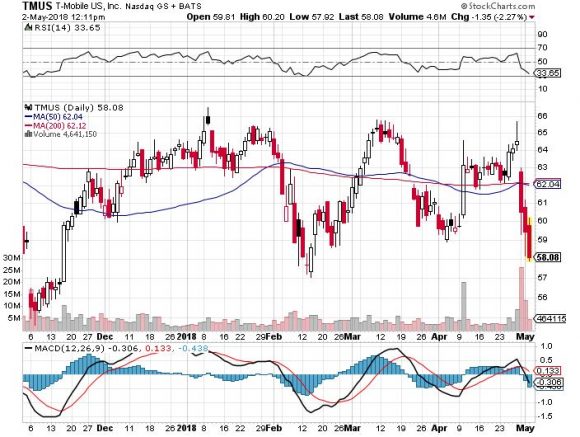
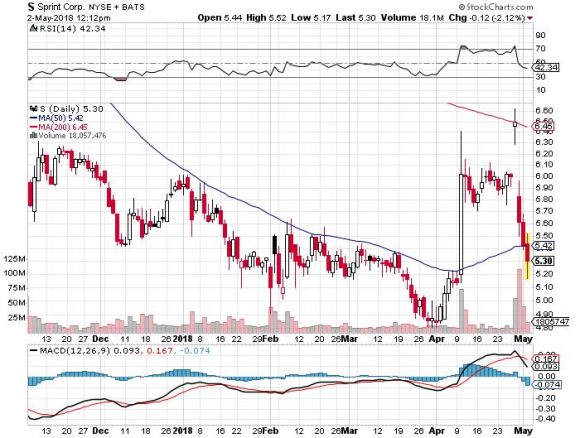
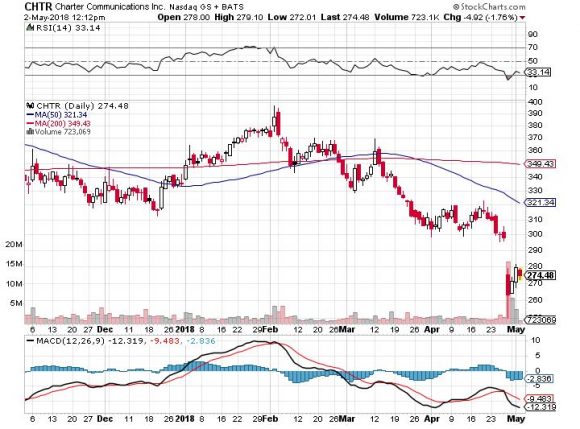
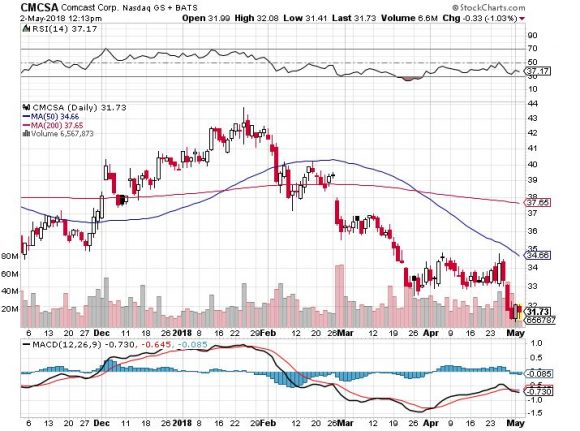
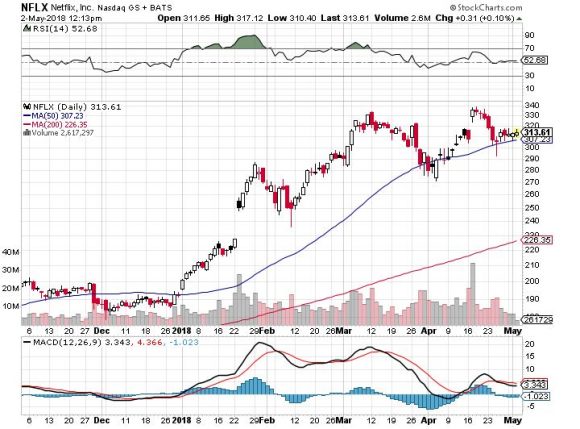
_________________________________________________________________________________________________
Quote of the Day
"Everything is designed. Few things are designed well." - said radio producer Brian Reed

Legal Disclaimer
There is a very high degree of risk involved in trading. Past results are not indicative of future returns. MadHedgeFundTrader.com and all individuals affiliated with this site assume no responsibilities for your trading and investment results. The indicators, strategies, columns, articles and all other features are for educational purposes only and should not be construed as investment advice. Information for futures trading observations are obtained from sources believed to be reliable, but we do not warrant its completeness or accuracy, or warrant any results from the use of the information. Your use of the trading observations is entirely at your own risk and it is your sole responsibility to evaluate the accuracy, completeness and usefulness of the information. You must assess the risk of any trade with your broker and make your own independent decisions regarding any securities mentioned herein. Affiliates of MadHedgeFundTrader.com may have a position or effect transactions in the securities described herein (or options thereon) and/or otherwise employ trading strategies that may be consistent or inconsistent with the provided strategies.
This site uses cookies. By continuing to browse the site, you are agreeing to our use of cookies.
OKLearn moreWe may request cookies to be set on your device. We use cookies to let us know when you visit our websites, how you interact with us, to enrich your user experience, and to customize your relationship with our website.
Click on the different category headings to find out more. You can also change some of your preferences. Note that blocking some types of cookies may impact your experience on our websites and the services we are able to offer.
These cookies are strictly necessary to provide you with services available through our website and to use some of its features.
Because these cookies are strictly necessary to deliver the website, refuseing them will have impact how our site functions. You always can block or delete cookies by changing your browser settings and force blocking all cookies on this website. But this will always prompt you to accept/refuse cookies when revisiting our site.
We fully respect if you want to refuse cookies but to avoid asking you again and again kindly allow us to store a cookie for that. You are free to opt out any time or opt in for other cookies to get a better experience. If you refuse cookies we will remove all set cookies in our domain.
We provide you with a list of stored cookies on your computer in our domain so you can check what we stored. Due to security reasons we are not able to show or modify cookies from other domains. You can check these in your browser security settings.
These cookies collect information that is used either in aggregate form to help us understand how our website is being used or how effective our marketing campaigns are, or to help us customize our website and application for you in order to enhance your experience.
If you do not want that we track your visist to our site you can disable tracking in your browser here:
We also use different external services like Google Webfonts, Google Maps, and external Video providers. Since these providers may collect personal data like your IP address we allow you to block them here. Please be aware that this might heavily reduce the functionality and appearance of our site. Changes will take effect once you reload the page.
Google Webfont Settings:
Google Map Settings:
Vimeo and Youtube video embeds:
